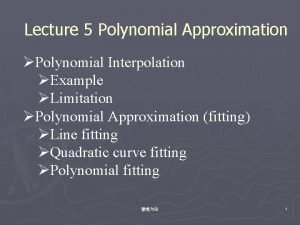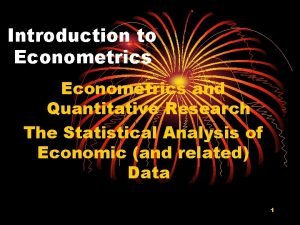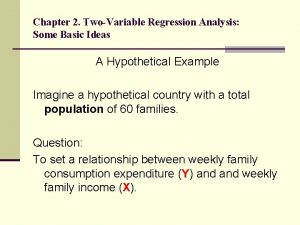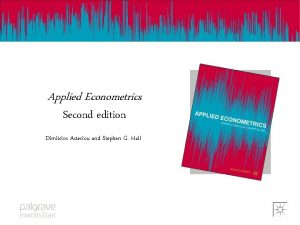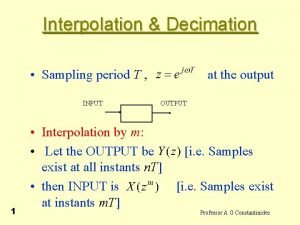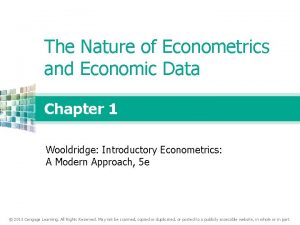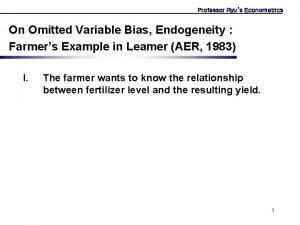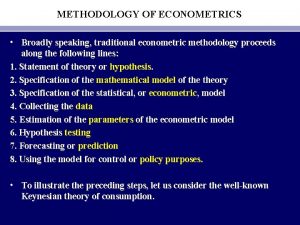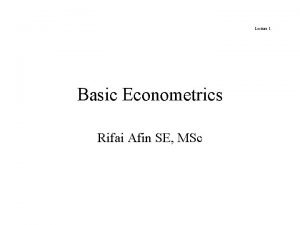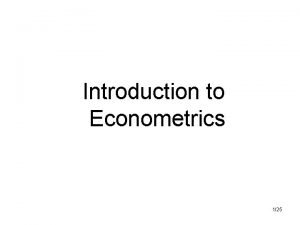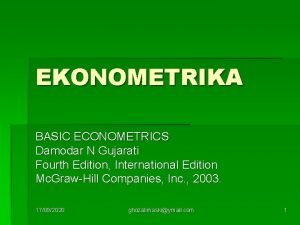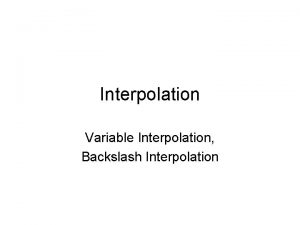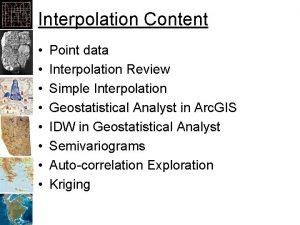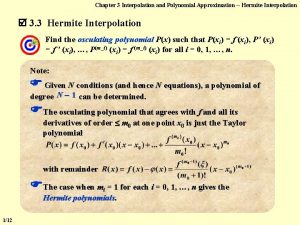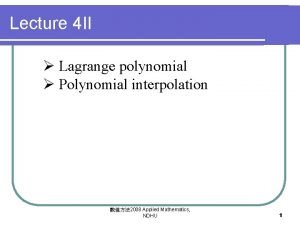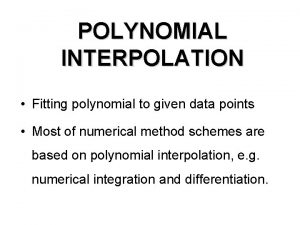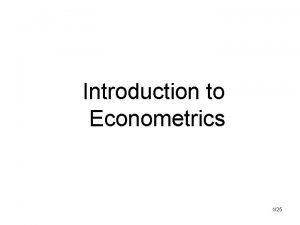Economics and Polynomial Interpolation Econometrics o Econometrics is

























- Slides: 25

Economics and Polynomial Interpolation

Econometrics o Econometrics is the use of the statistical methods and techniques to understand the test theories as well as economic issues. o Modeling choices and preferences of customers with the use of the econometric approach could improve the strategy of a firm, decision making and hence save resources as well as costs. o It helps in decision making in areas where the risk factor is high, thus econometric modeling could help reduce the risk exposure as well as predict outcomes with some probability to make the process of decision making considerably easier o Econometrics modeling could drive the business ahead, help in optimization of cost, better or smarter decision making and better understanding of the customer demand in the market

Introduction Economics is the social science that does not only explain what goes on in economy of a country but also describes how the economy operates as well as make predictions relative to what might happen to specific variables of economy if certain changes take place. 3 main types of Economic Data – 1) Time – Series 2) Cross-Sectional 3) Panel Data

Time Series Data o. Most Basic Data Set o. Observations Over Time o. E. g. US GDP over 10 years o. Natural, chronological ordering 4

Cross Sectional Data o. Data is measured across subjects rather than across time o. No natural ordering o. E. g- GDP of all North American Countries in 2020 5

Panel Data Sets 6 o. Repeated observations over time on the same set of cross-sectional units o. Provides time series observations for each cross-sectional member in the data set. o. E. g- GDP of All North American Countries from 2012 -2020 o. Advantages of Panel Data Sets?

Panel Data Sets Advantages- Larger number of observations Allows to control for unobservables/omitted variables Easier estimation and inference 7

Simple Linear Regressions Definition: Linear regression models with a single explanatory variable o Simple Linear Regressions will show either negative, positive or a zero relationship between dependent and independent variables: Negative 8 Zero Positive

Simple Linear Regressions 9

Interpretation of Population Regression Function 10

Polynomial Interpolation What if we want to be more precise? Can we use the line of best fit to estimate the value of one variable from the value of another variable What if we closed off the x interval to where we have a finite amount of data points and work in a more compact space. 11

Taylor Polynomial 12

Taylor Polynomial 13

The Vandermonde Matrix

Lagrange Interpolation

Lagrange Interpolation If given n+1 data points, there exists a unique Lagrange Polynomial of degree n that will go through all the data points

Newtons Interpolation Very similar to Lagrange interpolation Overcomes the instability associated with Lagrange method Newton interpolation begins with basis functions, (polynomial of order 0) entering the first data point and then successively incorporates each remaining data point with nested multiplication.

Other Applications of Mathematics in Economics

Mathematical optimization The mathematical optimization is used as an instrument for the qualitative analysis as well as for the wider range of applications in economies which are as follows; • Efficiency analysis • Industrial economics • International economics • Input-output economics, • Quantitative economics and • Environmental economics One of the types of the mathematical optimization is the linear optimization which is used to achieve the best outcome such as lowest cost or maximum profit in the mathematical model the requirements of which are represented by the linear relationship. The linear programing help economists to make processes both cost effective and efficient

Mathematical optimization in Economics Economic Optimization problems generally involve three elements: 1) The objective function, f(x) to be maximized or minimized 2) Choice variable(s), x, determine the value of the objective function 3) Constraints that may restrict the values of choice variables

Minimization and maximization The profit maximization objective could be achieved when the marginal revenue is equal to the marginal cost. Profit maximization marginal revenue (MR) = marginal cost (MC) The rule of minimizing the cost of operations is that all the levels of the labor and capital such as marginal product of labor divided by wage is equal to the marginal product of capital divided by the capital rental price. MPL / w > MPK / r

Minimization and maximization Technical factors The use of fixed factors Production function Economic factors Cost function C = Cc(q) The price of the inputs Market factors Revenue function The type of competition R = R(q) The market demand

Game theory With the use of theory of game, the real-world scenarios for various situations such as product releases as well as pricing competition could be laid out and the outcomes could be estimated. Economists often use game theory in order to understand the behavior of oligopoly firm and it help to easily predict the likely outcomes and results when firms tend to engage in certain behaviors such as collusion and price-fixing. The wider application of game theory in economics ranges from analysis of economic competition to the economic phenomenon such as voting theory, bargaining mechanism design, political economy, behavioral economics and experimental economics

Reference • Chakure, A. (2019, June 29). Linear Regression and its Mathematical implementation. • Intriligator, M. D. (2002 , Jan 01). Mathematical Optimization and Economic Theory. • Krukrubo, L. A. (2019, May 16). Understanding The simple Mathematics Behind Simple Linear Regression. • Pardalos, P. M. (2019). MATHEMATICAL OPTIMIZATION AND ECONOMIC ANALYSIS. • Rosser, M. (2018). Basic mathematics for economists. • Sampson, M. (2015). Mathematical Economics. • Sarkar, S. (2020). ECONOMETRIC MODELLING: HOW IT CAN HELP IN BUSINESS. • Shayle R. Searle, L. S. (2001, September). Matrix Algebra for Applied Economics. • Tucker, A. (1993). The Growing Importance of Linear Algebra in Undergraduate Mathematics. The College Mathematics Journal, , pp. 3 -9. Yi. Li Chien and Paul Morris, "PMI and GDP: Do They Correlate for the United States? For China? , " Economic Synopses, No. 6, 2016. https: //doi. org/10. 20955/es. 2016. 6

THANK YOU!
 Spline interpolation vs polynomial interpolation
Spline interpolation vs polynomial interpolation Econometrics and quantitative economics
Econometrics and quantitative economics Neville's algorithm
Neville's algorithm Polynomial interpolation
Polynomial interpolation Interpolation economics
Interpolation economics Numpy.polynomial.polynomial
Numpy.polynomial.polynomial How to divide a polynomial by another polynomial
How to divide a polynomial by another polynomial Economics and business economics maastricht
Economics and business economics maastricht Mathematical economics vs non mathematical economics
Mathematical economics vs non mathematical economics Nature and scope of econometrics
Nature and scope of econometrics Srf and prf in econometrics
Srf and prf in econometrics Applied econometrics asteriou
Applied econometrics asteriou Interpolation and decimation
Interpolation and decimation Interpolation in numerical analysis
Interpolation in numerical analysis Interpolation vs approximation
Interpolation vs approximation Probit econometrics
Probit econometrics Nature of econometrics
Nature of econometrics Confidence interval econometrics
Confidence interval econometrics Endogeneity econometrics
Endogeneity econometrics Dataset for multiple regression
Dataset for multiple regression Gujarati econometrics
Gujarati econometrics Traditional methodology of econometrics
Traditional methodology of econometrics Methodology of econometrics
Methodology of econometrics Importance of statistics in finance
Importance of statistics in finance Methodology of econometric analysis
Methodology of econometric analysis Gujarati ekonometrika
Gujarati ekonometrika
